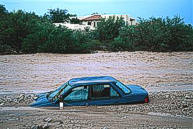Local weather forecast by
"City, St" or zip code |
Search by city or zip code. Press enter or select the go button to submit request |
|
 Each year, more deaths occur due to flooding than from any other thunderstorm related hazard. Why? The main reason is people underestimate the force and power of water. Many of the deaths occur in automobiles as they are swept downstream. Of these drownings, many are preventable, but too many people continue to drive around the barriers that warn you the road is flooded. Each year, more deaths occur due to flooding than from any other thunderstorm related hazard. Why? The main reason is people underestimate the force and power of water. Many of the deaths occur in automobiles as they are swept downstream. Of these drownings, many are preventable, but too many people continue to drive around the barriers that warn you the road is flooded.
Whether you are driving or walking, if you come to a flooded road, Turn Around Don't Drown®
You will not know the depth of the water nor will you know the condition of the road under the water. |
|
Follow these safety rules:
- Monitor the NOAA Weather Radio, or your favorite news source for vital weather related information.
- If flooding occurs, get to higher ground. Get out of areas subject to flooding. This includes dips, low spots, canyons, washes etc.
- Avoid areas already flooded, especially if the water is flowing fast. Do not attempt to cross flowing streams. Turn Around Don't Drown ®
- Road beds may be washed out under flood waters. NEVER drive through flooded roadways. Turn Around Don't Drown ® If your vehicle is suddenly caught in rising water, leave it immediately and seek higher ground.
- Do not camp or park your vehicle along streams and washes, particularly during threatening conditions.
- Be especially cautious at night when it is harder to recognize flood dangers.
Flash Floods
 Except for heat related fatalities, more deaths occur from flooding than any other hazard. Why? Most people fail to realize the power of water. For example, six inches of fast-moving flood water can knock you off your feet. Except for heat related fatalities, more deaths occur from flooding than any other hazard. Why? Most people fail to realize the power of water. For example, six inches of fast-moving flood water can knock you off your feet.
While the number of fatalities can vary dramatically with weather conditions from year to year, the national 30-year average for flood deaths is 127. That compares with a 30-year average of 73 deaths for lightning, 65 for tornadoes and 16 for hurricanes.
National Weather Service data also shows:
- Nearly half of all flash flood fatalities are vehicle-related,
- The majority of victims are males, and
- Flood deaths affect all age groups.
Most flash floods are caused by slow moving thunderstorms, thunderstorms that move repeatedly over the same area or heavy rains from tropical storms and hurricanes.  These floods can develop within minutes or hours depending on the intensity and duration of the rain, the topography, soil conditions and ground cover. These floods can develop within minutes or hours depending on the intensity and duration of the rain, the topography, soil conditions and ground cover.
Flash floods can roll boulders, tear out trees, destroy buildings and bridges, and scour out new channels. Rapidly rising water can reach heights of 30 feet or more. Furthermore, flash flood-producing rains can also trigger catastrophic mud slides.
Occasionally, floating debris or ice can accumulate at a natural or man-made obstruction and restrict the flow of water. Water held back by the ice jam or debris dam can cause flooding upstream. Subsequent flash flooding can occur downstream if the obstruction should suddenly release. More information can be obtained at the Southern Region Flood Hazards Page.
Turn Around Don't Drown® Outreach Materials in PDF format: |
|
Turn Around Don't Drown® Partners with the National Weather Service and
|
|
National Weather Service
Southern Region Headquarters
819 Taylor Street, Room 10A26
Fort Worth, TX 76102
Page last modified: August 24, 2004 |
Disclaimer |
Privacy Policy |
|

 National Weather Service
National Weather Service